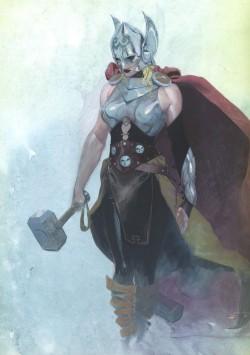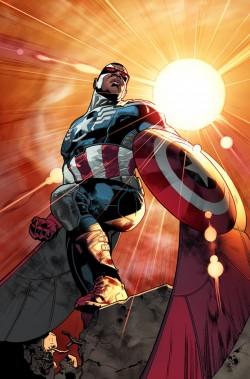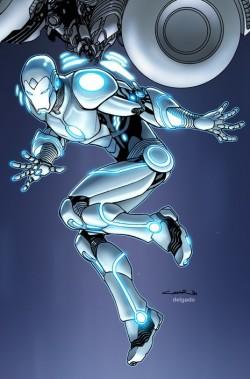Here’s how this went down: early Tuesday morning Marvel announced that its comic book version of Thor was going to be replaced by a mysterious (new or pre-existing) female character who would wield his hammer and carry the title of “Thor.” Less than 24 hours later I saw the first of what I’m sure will be many lists of actresses who could play the female Thor on film. We won’t even get our first extended look at this new Thor in the comics until October, but the internet has no such patience for that. Instead, let’s talk about why Marvel must cast either Gwendoline Christie (Game of Thrones), Ronda Rousey (UFC figher whose first movie isn’t even out yet), Margot Robbie (Wolf of Wall Street), or Ireland Baldwin (Grudge Match) to replace Chris Hemsworth or somehow have Jamie Alexander do it since she’s already around as Sif.
A lot of this actually comes down to how much we somewhat improbably know about the contracts all of the Marvel actors have signed. We know that Hemsworth is only contractually obligated to play Thor in two more Avengers films, which does include next summer’s Avengers: Age of Ultron, and one more Thor sequel. We know that Chris Evans is pretty much operating under the same deal, and has actually stated his intention to retire from acting after he fulfills his contract with Avengers 3. We also know that Robert Downey, Jr. is only under contract for Age of Ultron and Avengers 3.

The new Thor, whose real identity will remain a mystery for a while

Sam Wilson as the new Captain America

Tony Stark’s Apple-esque new Superior Iron Man
Now, all of a sudden in the course of one week the comic book side of Marvel announces swift changes to Thor (replaced by a woman), Captain America (replaced by best bud and former sidekick Sam “Falcon” Wilson), and Iron Man (relocating from New York to San Francisco and becoming “Superior Iron Man,” a title which usually connotes some kind of big change, usually titling toward evil). It’s very easy to look at this as a company which is quickly crafting an exit-plan since it has been historically reluctant to pay up and give its actors new contracts. Why not test-run potential replacements in the comics?
Of course, by that logic we would have already seen Miles Morales as Spider-Man on film by now instead of Andrew Garfield’s Morrissey-esque take on Peter Parker.
Then again, Marvel doesn’t actually own the film rights to Spider-Man (meaning they can go crazy in the comics all they want) whereas they own both the comics and film rights to Thor, Cap, and Iron Man. Clearly there is some mad corporate synergy going on here between Marvel Comics and Marvel Studios, right?
We give them far too much credit, or at least that’s the official company line toyed by Marvel Comics Editor-in-Chief Axel Alonso in a new interview with ComicBookResources:
All of these plans have been underway for months, and each of them came about independently. “All-New Captain America” came out of events in the core series, “Captain America.” “Thor” was birthed by an event in “Original Sin.” “Superior Iron Man” came about because of an event in “AXIS.” None of this happened because of some sort of editorial edict; it all came about because writers had stories they wanted to tell, the sum total of these developments represented a seismic change for the core three Avengers, and we decided to wrap a red ribbon around all of it.
In addition to the new versions of the big 3 Marvel is launching a new version of the Avengers called Avengers Now!, featuring the new big 3 along with the Winter Soldier, Scarlet Witch, Doctor Strange, Ant-Man, Deathlock, and several non-film/TV characters. It’s both strange that they’d change up the Avengers so close to the launch of Age of Ultron while at the same time not at all surprising that they’d want to elevate characters soon to appear on film (Scarlet Witch, Strange, Ant-Man) or one who recently showed up on TV (Deathlock on Agents of SHIELD). It calls to mind how DisneyXD canceled the animated series Avengers: Earth’s Mightiest Heroes and replaced it with Avengers Assemble featuring a roster of characters and costumes more in line with the live-action films.
Alonso still maintains it’s all a coincidence:
This is coincidence, not editorial edict. Jason had an idea for “Thor,” and Rick had ideas for both “Captain America” and an event he was planning — “AXIS” — that would profoundly affect Iron Man. They came to their ideas independently and they had to sell their editors first, then me, before we got my boss, Dan Buckley’s approval. The fact that these three events happened at more or less the same time was a pleasant coincidence that allowed us to wrap a promotional ribbon around them. In the specific case of Thor, “All-New Thor” puts an exclamation point on the recent launches featuring female leads that have helped us diversify our line, and maybe our readers
In fact, around the time the first Avengers film was coming out they actually almost killed off the Avengers in the comics:
At my very first summit as Marvel editor-in-chief, the one that birthed “Avengers vs. X-Men,” we seriously considered a plot twist that would have killed the Avengers — taking them completely off the table. Certain people advocated for that hard — I was not one of them! [Laughs] — and we were staring at an event that would overlap the first movie. Of course, that idea didn’t end up winning — thank God! — but it was on the table.
This is not about creating contingency plans for the future of the Marvel Cinematic Universe. This is about selling comic books, plain and simple:
Our job — my job — is to tell stories that sell comics. And we want all our comics to sell. For example, to the whole society of fans that think that we’re trying to bury or kill the X-Men [to tarnish the brand since we don't own the film rights] that’s just plain crazy. [Laughs] There’s a reason that Brian Michael Bendis is writing “All-New X-Men.” There’s a reason we’re doing “Death of Wolverine,” and promoting the hell out of it. Because we want them to sell. It’s important that we maintain and grow the popularity of characters that are already popular, and that we elevate characters we want to make popular — like Guardians of the Galaxy, Ant-Man, Inhumans and Doctor Strange.
Of course, those characters he name checks as wanting to “make popular” are all ones with films on the way and another (Inhumans) with a film stuck in development hell for years now.
Let’s not go crazy here. These types of changes in the comics tend to only last for a while until the next big movie comes out thus the need to re-set things back to the status quo, thus Miles Morales’ version of Spider-Man being canceled shortly after the new The Amazing Spider-Man films.

Mark Ruffalo’s already the third guy to play Hulk in the films. Could Cap, Thor, and Iron Man be re-cast at some point, too?
Yet we are definitely closer to the end of our time with Robert Downey, Jr. as Tony Stark than we are to the beginning, and Avengers 3 is sure shaping up to be a real blood-bath. By making Sam Wilson, who made his live action debut last April in Winter Soldier, into a potential new Captain America we now have two potential replacements for Chris Evans, Anthony Mackie’s Wilson and Sebastian Stan’s Bucky Barnes. One of them just happens to be black. I believe Axel Alonso when he says these changes in the comics came about organically and independently, but at the very least if audiences like the comics it does give Marvel Studios some new options down the road.
What do you think? Let us know in the comments.
Sources: FilmSchoolRejects, ComicBookResources

